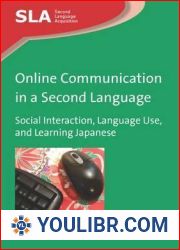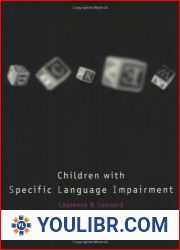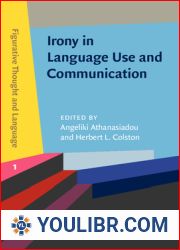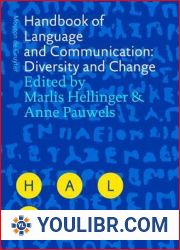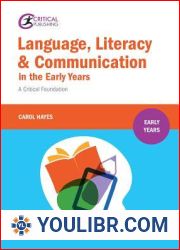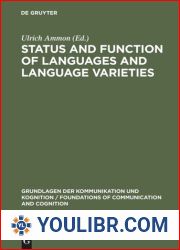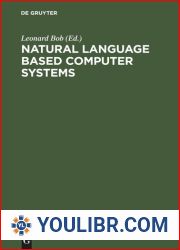
BOOKS - Online Communication in a Second Language: Social Interaction, Language Use, ...

Online Communication in a Second Language: Social Interaction, Language Use, and Learning Japanese (Second Language Acquisition, 66)
Author: Sarah E. Pasfield-Neofitou
Year: January 1, 2012
Format: PDF
File size: PDF 2.5 MB
Language: English
Year: January 1, 2012
Format: PDF
File size: PDF 2.5 MB
Language: English
Online Communication in a Second Language examines the use of social computer mediated communication (CMC) with speakers of Japanese via longitudinal case studies of up to four years. Through the analysis of over 2000 blogs, emails, videos, messages, games, and websites, in addition to interviews with learners and their online contacts, the book explores language use and acquisition via contextual resources, repair, and peer feedback. The book provides insight into relationships online, and the influence of perceived 'ownership' of online spaces by specific cultural or linguistic groups. It not only increases our understanding of online interaction in a second language, but CMC in general. Based on empirical evidence, the study challenges traditional categorisations of CMC mediums, and provides important insights relating to turn-taking, code-switching, and language management online.
La comunicazione online nella seconda lingua Interazione sociale, l'uso della lingua e l'apprendimento della lingua giapponese come apprendimento della seconda lingua Nell'era digitale moderna, la tecnologia è diventata parte integrante della nostra vita quotidiana, ed è particolarmente rilevante quando si tratta di imparare la seconda lingua. Con l'aumento della comunicazione online, gli studiosi di lingua possono ora interagire con i supporter di lingua di tutto il mondo, offrendo loro preziose opportunità di pratica linguistica e feedback. Tuttavia, questo crea nuovi problemi, come la navigazione su diverse piattaforme di comunicazione e la gestione delle interazioni interattive nella seconda lingua. La comunicazione online in seconda lingua esamina l'uso della comunicazione social informatica (CMC) con i portatori di lingua giapponese, fornendo preziose informazioni su come gli apprendisti di lingua utilizzano questi strumenti per migliorare le loro competenze linguistiche. Il libro si basa su studi tematici longitudinali che durano fino a quattro anni, analizzando oltre 2000 blog, email, video, messaggi, giochi e siti web, e interviste con studenti e i loro contatti online. Con questo approccio complesso, l'autore esplora l'uso e l'apprendimento del linguaggio con risorse contestuali, riparazioni e recensioni dei coetanei. Communication en ligne dans la deuxième langue Interaction sociale, utilisation de la langue et apprentissage du japonais comme assimilation de la deuxième langue À l'ère numérique moderne, la technologie est devenue une partie intégrante de notre vie quotidienne, et cela est particulièrement pertinent lorsqu'il s'agit d'apprendre une deuxième langue. Avec la croissance de la communication en ligne, les apprenants peuvent maintenant interagir avec des locuteurs natifs du monde entier, leur offrant de précieuses possibilités de pratique linguistique et de rétroaction. Cependant, cela pose également de nouveaux défis, comme la navigation sur les différentes plateformes de communication et la gestion des interactions interactives en langue seconde. La communication en ligne dans la langue seconde explore l'utilisation de la communication sociale par ordinateur (CMC) avec les personnes de langue maternelle japonaise, fournissant des informations précieuses sur la façon dont les apprenants utilisent ces outils pour améliorer leurs compétences linguistiques. livre est basé sur des études de cas longitudinales qui durent jusqu'à quatre ans, analysant plus de 2000 blogs, e-mails, vidéos, posts, jeux et sites Web, ainsi que des interviews avec les apprenants et leurs contacts en ligne. Grâce à cette approche intégrée, l'auteur explore l'utilisation et l'assimilation de la langue à travers les ressources contextuelles, les réparations et les commentaires des pairs. Comunicação online em segunda língua Interação Social, Uso da Língua e Aprendizado da Língua Japonesa como Aprendizado da Segunda Língua Na Era Digital Moderna, a tecnologia tornou-se parte integrante do nosso dia a dia, e isso é particularmente relevante quando se trata de aprender uma segunda língua. Com o aumento da comunicação on-line, os aprendizadores agora podem interagir com os usuários de línguas de todo o mundo, oferecendo-lhes oportunidades valiosas para práticas linguísticas e feedback. No entanto, isso também traz novos desafios, como navegar em várias plataformas de comunicação e gerenciar interações em segunda língua. A comunicação online na segunda língua explora o uso da comunicação social por computador (CMC) com os portadores de língua japonesa, fornecendo informações valiosas sobre como os aprendiz o idioma usa essas ferramentas para melhorar suas habilidades linguísticas. O livro é baseado em estudos de caso longevidade que duram até quatro anos, analisando mais de 2.000 blogs, e-mails, vídeos, mensagens, jogos e sites, além de entrevistas com alunos e seus contatos online. Através desta abordagem complexa, o autor explora o uso e o aprendizado da linguagem através de recursos contextuais, reparos e comentários de seus pares. Comunicación en línea en un segundo idioma La interacción social, el uso del idioma y el aprendizaje del japonés como segunda lengua En la era digital moderna, la tecnología se ha convertido en una parte integral de nuestra vida cotidiana, y esto es especialmente relevante cuando se trata de aprender un segundo idioma. Con el crecimiento de la comunicación en línea, los estudiantes de idiomas ahora pueden interactuar con hablantes nativos de todo el mundo, brindándoles valiosas oportunidades para la práctica del idioma y la retroalimentación. n embargo, también plantea nuevos retos, como navegar por diferentes plataformas de comunicación y gestionar las interacciones interactivas en un segundo idioma. La comunicación en línea en el segundo idioma explora el uso de la comunicación social por computadora (CMC) con hablantes nativos japoneses, proporcionando información valiosa sobre cómo los aprendices de idiomas usan estas herramientas para mejorar sus habilidades lingüísticas. libro se basa en estudios de caso longitudinales que duran hasta cuatro , analizando más de 2.000 blogs, correos electrónicos, videos, mensajes, juegos y sitios web, así como entrevistas con estudiantes y sus contactos en línea. Con este enfoque integral, el autor explora el uso y la asimilación del lenguaje a través de recursos contextuales, reparaciones y retroalimentación entre pares. Komunikacja online w drugim języku Interakcja społeczna, używanie języka i nauka języka japońskiego jako drugiego nabycia języka W nowoczesnej erze cyfrowej technologia stała się integralną częścią naszego codziennego życia, co jest szczególnie prawdziwe, jeśli chodzi o naukę drugiego języka. Wraz ze wzrostem komunikacji online, nauczyciele języka mogą teraz współdziałać z native speakerami z całego świata, zapewniając im cenne możliwości praktyki językowej i informacji zwrotnych. Stwarza ona jednak również nowe wyzwania, takie jak nawigacja po różnych platformach komunikacyjnych i zarządzanie interaktywnymi interakcjami w drugim języku. Internetowa komunikacja w drugim języku bada wykorzystanie komunikacji społecznościowej (CMC) z japońskimi mówcami, dostarczając cennych informacji na temat tego, w jaki sposób uczący się języków używają tych narzędzi w celu poprawy ich umiejętności językowych. Książka oparta jest na podłużnych studiach przypadków, które trwają do czterech lat, analizując ponad 2000 blogów, e-maili, filmów, postów, gier i stron internetowych, a także wywiadów ze studentami i ich kontaktów online. Dzięki temu wszechstronnemu podejściu autor bada używanie i pozyskiwanie języków poprzez zasoby kontekstowe, naprawy i wzajemne opinie. 第二語言在線交流社會互動、語言使用和日語學習作為第二語言學習在現代數字時代,技術已成為我們日常生活不可或缺的一部分,在學習第二語言時尤其如此。隨著在線交流的興起,學習語言的人現在可以與來自世界各地的母語人士互動,為他們提供寶貴的語言實踐和反饋機會。但是,這也帶來了新的挑戰,例如導航各種通信平臺和管理第二語言的交互式交互。第二語言在線交流探討了與日語使用者使用社交計算機通信(CMC)的情況,提供了有關學習語言的人如何使用這些工具來提高其語言技能的寶貴信息。該書基於長達四的縱向案例研究,分析了2000多個博客,電子郵件,視頻,消息,遊戲和網站,以及對學生及其在線聯系人的采訪。通過這種綜合方法,作者通過上下文資源,修復和同伴反饋來探索語言的使用和吸收。
İkinci bir dilde çevrimiçi iletişim Sosyal etkileşim, dil kullanımı ve ikinci bir dil edinimi olarak Japonca öğrenmek Modern dijital çağda, teknoloji günlük hayatımızın ayrılmaz bir parçası haline gelmiştir ve bu özellikle ikinci bir dil öğrenmek söz konusu olduğunda geçerlidir. Çevrimiçi iletişimin büyümesiyle, dil öğrenenler artık dünyanın dört bir yanından ana dili konuşanlarla etkileşime girebilir ve onlara dil pratiği ve geri bildirim için değerli fırsatlar sunar. Bununla birlikte, farklı iletişim platformlarında gezinmek ve ikinci bir dilde etkileşimli etkileşimleri yönetmek gibi yeni zorluklar da ortaya çıkarmaktadır. Çevrimiçi ikinci dil iletişimi, Japonca konuşanlarla sosyal bilgisayar iletişiminin (CMC) kullanımını araştırır ve dil öğrenenlerin dil becerilerini geliştirmek için bu araçları nasıl kullandıklarına dair değerli bilgiler sağlar. Kitap, dört yıla kadar süren, 2.000'den fazla blog, e-posta, video, gönderi, oyun ve web sitesinin yanı sıra öğrencilerle ve çevrimiçi bağlantılarıyla yapılan röportajları analiz eden uzunlamasına vaka çalışmalarına dayanmaktadır. Bu kapsamlı yaklaşımla, yazar bağlamsal kaynaklar, onarım ve akran geri bildirimi yoluyla dil kullanımını ve edinimini araştırıyor. תקשורת מקוונת בשפה שנייה אינטראקציה חברתית, שימוש בשפה ולמידה יפנית כרכישת שפה שנייה בעידן הדיגיטלי המודרני, הטכנולוגיה הפכה לחלק בלתי נפרד מחיי היום יום שלנו, וזה נכון במיוחד כשמדובר בלימוד שפה שנייה. עם צמיחת התקשורת המקוונת, לומדים שפה יכולים כיום לתקשר עם דוברי ילידים מרחבי העולם, ולספק להם הזדמנויות יקרות לתרגול שפה ומשוב. עם זאת, הוא גם מציב אתגרים חדשים, כגון ניווט פלטפורמות תקשורת שונות וניהול אינטראקציות אינטראקטיביות בשפה שנייה. תקשורת שפה שנייה מקוונת חוקרת את השימוש בתקשורת מחשבים חברתית (CMC) עם דוברי יפנית, ומספקת מידע רב ערך על אופן השימוש של לומדי שפה בכלים אלה לשיפור כישורי השפה שלהם. הספר מבוסס על מחקרים ארוכי טווח הנמשכים עד ארבע שנים, ומנתח יותר מ-2,000 בלוגים, מיילים, סרטונים, פרסומים, משחקים ואתרי אינטרנט, כמו גם ראיונות עם סטודנטים ואנשי הקשר שלהם ברשת. באמצעות גישה מקיפה זו, המחבר חוקר שימוש ורכישה בשפה באמצעות משאבים קונטקסטואליים, תיקון ומשוב חברתי. Online-Kommunikation in der zweiten Sprache Soziale Interaktion, Sprachgebrauch und Japanischlernen als Zweitspracherwerb Im heutigen digitalen Zeitalter sind Technologien zu einem festen Bestandteil unseres Alltags geworden, und das gilt besonders, wenn es darum geht, eine zweite Sprache zu lernen. Mit der zunehmenden Online-Kommunikation können Sprachlernende jetzt mit Muttersprachlern aus der ganzen Welt interagieren und ihnen wertvolle Möglichkeiten für Sprachpraxis und Feedback bieten. Daraus ergeben sich aber auch neue Herausforderungen wie die Navigation auf verschiedenen Kommunikationsplattformen und die Steuerung interaktiver Interaktionen in einer zweiten Sprache. Online Communication in Second Language untersucht die Verwendung von Social Computer Communication (CMC) mit japanischen Muttersprachlern und liefert wertvolle Einblicke, wie Sprachlernende diese Tools nutzen, um ihre Sprachkenntnisse zu verbessern. Das Buch basiert auf longitudinalen Fallstudien, die bis zu vier Jahre dauern und mehr als 2.000 Blogs, E-Mails, Videos, Beiträge, Spiele und Websites sowie Interviews mit rnenden und ihren Online-Kontakten analysieren. Mit diesem integrierten Ansatz untersucht der Autor die Verwendung und den Spracherwerb mit kontextuellen Ressourcen, Reparaturen und Peer-Feedback. 제 2 언어 사회적 상호 작용, 언어 사용 및 제 2 언어 습득으로 일본어를 배우는 온라인 커뮤니케이션 현대 디지털 시대에 기술은 일상 생활에서 없어서는 안될 부분이되었으며, 제 2 언어를 배우는 데있어 특히 그렇습니다. 온라인 커뮤니케이션이 성장함에 따라 언어 학습자는 이제 전 세계의 원어민과 교류하여 언어 실습 및 피드백을위한 귀중한 기회를 제공 할 수 있습니다. 그러나 다양한 통신 플랫폼 탐색 및 대화 형 상호 작용 관리와 같은 새로운 과제도 제기합니다. 온라인 제 2 언어 커뮤니케이션은 일본어 사용자와 소셜 컴퓨터 커뮤니케이션 (CMC) 을 사용하여 언어 학습자가 언어 능력을 향상시키기 위해 이러한 도구를 사용하는 방법에 대 이 책은 최대 4 년 동안 지속되는 종단 사례 연구를 기반으로하며 2,000 개 이상의 블로그, 이메일, 비디오, 게시물, 게임 및 웹 사이트를 분석하고 학생 및 온라인 담당자와의 인터뷰를 분석합니다. 이 포괄적 인 접근 방식을 통해 저자는 상황에 맞는 리소스, 수리 및 동료 피드백을 통해 언어 사용 및 획득을 탐구합니다. Online Communication in a Second Language Social Interaction, Language Use, and Learning Japanese as a Second Language Acquisition In today's digital age, technology has become an integral part of our daily lives, and this is especially true when it comes to learning a second language. With the rise of online communication, language learners can now interact with native speakers from all over the world, providing them with valuable opportunities for language practice and feedback. However, this also presents new challenges, such as navigating different communication platforms and managing online interactions in a second language. Online Communication in a Second Language examines the use of social computer-mediated communication (CMC) with speakers of Japanese, providing valuable insights into how language learners use these tools to improve their language skills. The book is based on longitudinal case studies that last up to four years, analyzing over 2000 blogs, emails, videos, messages, games, and websites, as well as interviews with learners and their online contacts. Through this comprehensive approach, the author explores language use and acquisition via contextual resources, repair, and peer feedback. 第二言語でのオンラインコミュニケーション社会的相互作用、言語使用、第二言語取得としての日本語の学習現代のデジタル時代において、テクノロジーは私たちの日常生活の不可欠な部分となっています。オンラインコミュニケーションの成長により、語学学習者は世界中のネイティブスピーカーと対話できるようになり、言語実践やフィードバックのための貴重な機会を提供します。しかし、異なるコミュニケーションプラットフォームをナビゲートしたり、第二言語でインタラクティブなインタラクションを管理したりするなど、新しい課題もあります。オンライン第二言語コミュニケーションでは、日本語話者とのソーシャルコンピュータコミュニケーション(CMC)の活用を模索し、語学学習者がこれらのツールをどのように使用して言語スキルを向上させるかについて貴重な情報を提供します。この本は、最大4間の縦断ケーススタディに基づいており、2,000以上のブログ、電子メール、ビデオ、投稿、ゲーム、ウェブサイト、および学生とそのオンライン連絡先へのインタビューを分析しています。この包括的なアプローチを通じて、文脈的なリソース、修復、およびピアフィードバックを通じて言語の使用と取得を探求します。 التواصل عبر الإنترنت بلغة ثانية التفاعل الاجتماعي واستخدام اللغة وتعلم اللغة اليابانية كاكتساب لغة ثانية في العصر الرقمي الحديث، أصبحت التكنولوجيا جزءًا لا يتجزأ من حياتنا اليومية، وهذا صحيح بشكل خاص عندما يتعلق الأمر بتعلم لغة ثانية. مع نمو التواصل عبر الإنترنت، يمكن لمتعلمي اللغة الآن التفاعل مع المتحدثين الأصليين من جميع أنحاء العالم، مما يوفر لهم فرصًا قيمة لممارسة اللغة والتعليقات. ومع ذلك، فإنه يطرح أيضًا تحديات جديدة، مثل التنقل في منصات الاتصال المختلفة وإدارة التفاعلات التفاعلية بلغة ثانية. يستكشف الاتصال باللغة الثانية عبر الإنترنت استخدام الاتصال الحاسوبي الاجتماعي (CMC) مع المتحدثين باللغة اليابانية، مما يوفر معلومات قيمة حول كيفية استخدام متعلمي اللغة لهذه الأدوات لتحسين مهاراتهم اللغوية. يستند الكتاب إلى دراسات حالة طولية تستمر حتى أربع سنوات، وتحلل أكثر من 2000 مدونة ورسالة بريد إلكتروني ومقاطع فيديو ومنشورات وألعاب ومواقع ويب، بالإضافة إلى مقابلات مع الطلاب وجهات الاتصال الخاصة بهم عبر الإنترنت. من خلال هذا النهج الشامل، يستكشف المؤلف استخدام اللغة واكتسابها من خلال الموارد السياقية والإصلاح وتعليقات الأقران. Онлайн-общение на втором языке Социальное взаимодействие, использование языка и изучение японского языка как усвоение второго языка В современную цифровую эпоху технологии стали неотъемлемой частью нашей повседневной жизни, и это особенно актуально, когда речь идет об изучении второго языка. С ростом онлайн-общения изучающие язык теперь могут взаимодействовать с носителями языка со всего мира, предоставляя им ценные возможности для языковой практики и обратной связи. Однако это также создает новые проблемы, такие как навигация по различным коммуникационным платформам и управление интерактивными взаимодействиями на втором языке. Онлайн-общение на втором языке исследует использование социального компьютерного общения (CMC) с носителями японского языка, предоставляя ценную информацию о том, как изучающие язык используют эти инструменты для улучшения своих языковых навыков. Книга основана на продольных тематических исследованиях, которые длятся до четырех лет, анализируя более 2000 блогов, электронных писем, видео, сообщений, игр и веб-сайтов, а также интервью с учащимися и их онлайн-контактами. С помощью этого комплексного подхода автор исследует использование и усвоение языка с помощью контекстуальных ресурсов, ремонта и отзывов сверстников. تنزيل ملف pdf التواصل عبر الإنترنت بلغة ثانية التفاعل الاجتماعي واستخدام اللغة وتعلم اللغة اليابانية (تعلم لغة ثانية، 66) להוריד קובץ PDF תקשורת מקוונת בשפה שנייה אינטראקציה חברתית, שימוש בשפה ולמידה יפנית (לימוד שפה שנייה, 66) descargar archivo pdf Comunicación en Internet en el segundo idioma Interacción social, uso del idioma y aprendizaje del japonés (aprendizaje del segundo idioma, 66) pdf dosyasını indir İkinci bir dilde çevrimiçi iletişim Sosyal etkileşim, dil kullanımı ve Japonca öğrenme (ikinci bir dil öğrenme, 66) скачать файл PDF Общение в Интернете на втором языке Социальное взаимодействие, использование языка и изучение японского (изучение второго языка, 66) pobierz plik pdf Komunikacja online w drugim języku Interakcja społeczna, używanie języka i nauka języka japońskiego (nauka drugiego języka, 66) descarregar ficheiro pdf Comunicação online no segundo idioma Interação social, uso da língua e aprendizado do japonês (aprender o segundo idioma, 66) 下载 pdf 文件 第二語言在線交流社會互動、語言使用和日語學習(第二語言學習,66)
télécharger le fichier pdf Communication en ligne en langue seconde Interaction sociale, utilisation de la langue et apprentissage du japonais (apprentissage de la langue seconde, 66) Scarica il file pdf Comunicazione online nella seconda lingua Interazione sociale, uso della lingua e studio del giapponese (imparare la seconda lingua, 66) PDF-Datei herunterladen Online-Kommunikation in Zweitsprache Soziale Interaktion, Sprachgebrauch und Japanisch lernen (Zweitsprache lernen, 66) download pdf file pdf 파일 다운로드 제 2 언어 사회적 상호 작용, 언어 사용 및 일본어 학습 온라인 커뮤니케이션 (제 2 언어 학습, 66) PDFファイルをダウンロード 第二言語でのオンラインコミュニケーション社会的相互作用、言語使用と日本語を学ぶ(第二言語を学ぶ、66) download pdf file Online Communication in a Second Language: Social Interaction, Language Use, and Learning Japanese (Second Language Acquisition, 66)
La communication en ligne en langue seconde explore l'utilisation de la communication sociale par ordinateur (CMC) avec des personnes de langue maternelle japonaise à travers des études de cas longitudinales jusqu'à quatre ans. En analysant plus de 2000 blogs, e-mails, vidéos, posts, jeux et sites Web, en plus d'interviews avec les apprenants et leurs contacts en ligne, le livre explore l'utilisation et l'assimilation de la langue à l'aide de ressources contextuelles, de réparations et de commentaires de pairs. Le livre donne une idée des relations sur Internet et de l'impact de la « propriété » perçue des espaces en ligne par des groupes culturels ou linguistiques spécifiques. Cela améliore non seulement notre compréhension de l'interaction en ligne dans la langue seconde, mais aussi celle du CMC dans son ensemble. Sur la base de données empiriques, l'étude remet en question les classifications traditionnelles des médias du CMC et fournit des informations importantes sur la rotation, le changement de code et la gestion de la langue sur Internet.
Онлайн-общение на втором языке исследует использование социального компьютерного общения (CMC) с носителями японского языка с помощью продольных тематических исследований до четырех лет. Анализируя более 2000 блогов, электронных писем, видео, сообщений, игр и веб-сайтов, в дополнение к интервью с учащимися и их онлайн-контактами, книга исследует использование и усвоение языка с помощью контекстных ресурсов, ремонта и отзывов сверстников. Книга дает представление об отношениях в Интернете и влиянии предполагаемого владения онлайн-пространствами конкретными культурными или языковыми группами. Это не только повышает наше понимание онлайн-взаимодействия на втором языке, но и CMC в целом. Основываясь на эмпирических данных, исследование бросает вызов традиционным классификациям носителей CMC и дает важную информацию, касающуюся поворота, переключения кода и управления языком в Интернете.
A comunicação online em segunda língua explora o uso da comunicação social do computador (CMC) com portadores de língua japonesa por meio de estudos de caso longevais de até quatro anos. Analisando mais de 2.000 blogs, e-mails, vídeos, mensagens, jogos e sites, além de entrevistas com alunos e seus contatos online, o livro explora o uso e aprendizado da linguagem através de recursos contextuais, reparos e comentários de seus pares. O livro oferece uma visão das relações na Internet e do impacto dos espaços on-line percebidos por grupos culturais ou linguísticos específicos. Isso não só aumenta nossa compreensão da interação online no segundo idioma, mas também CMC em geral. Baseado em dados empíricos, o estudo desafia as classificações tradicionais de mídia CMC e fornece informações importantes sobre rotação, mudança de código e controle de linguagem na Internet.
La comunicación en línea en un segundo idioma explora el uso de la comunicación social por computadora (CMC) con hablantes nativos japoneses a través de estudios de caso longitudinales de hasta cuatro años. Analizando más de 2.000 blogs, correos electrónicos, videos, mensajes, juegos y sitios web, además de entrevistas con estudiantes y sus contactos en línea, el libro explora el uso y la asimilación del lenguaje a través de recursos contextuales, reparaciones y revisiones entre pares. El libro da una idea de las relaciones en Internet y el impacto de la percepción de 'posesión' de espacios online por parte de grupos culturales o lingüísticos específicos. Esto no solo aumenta nuestra comprensión de la interacción en línea en un segundo idioma, sino también de la CMC en general. Sobre la base de datos empíricos, el estudio desafía las clasificaciones tradicionales de portadores de CMC y proporciona información importante sobre el giro, el cambio de código y el control del lenguaje en Internet.
Online Communication in a Second Language examines the use of social computer mediated communication (CMC) with speakers of Japanese via longitudinal case studies of up to four years. Through the analysis of over 2000 blogs, emails, videos, messages, games, and websites, in addition to interviews with learners and their online contacts, the book explores language use and acquisition via contextual resources, repair, and peer feedback. The book provides insight into relationships online, and the influence of perceived 'ownership' of online spaces by specific cultural or linguistic groups. It not only increases our understanding of online interaction in a second language, but CMC in general. Based on empirical evidence, the study challenges traditional categorisations of CMC mediums, and provides important insights relating to turn-taking, code-switching, and language management online.
Online Communication in Second Language untersucht den Einsatz von Social Computer Communication (CMC) mit japanischen Muttersprachlern anhand von longitudinalen Fallstudien von bis zu vier Jahren. Durch die Analyse von mehr als 2.000 Blogs, E-Mails, Videos, Beiträgen, Spielen und Websites sowie Interviews mit Lernenden und ihren Online-Kontakten untersucht das Buch den Sprachgebrauch und den Spracherwerb durch kontextbezogene Ressourcen, Reparaturen und Peer-Feedback. Das Buch gibt einen Einblick in die Beziehungen im Internet und die Auswirkungen des wahrgenommenen „Besitzes“ von Online-Räumen durch bestimmte kulturelle oder sprachliche Gruppen. Dies erhöht nicht nur unser Verständnis von Online-Interaktionen in einer zweiten Sprache, sondern auch CMC als Ganzes. Basierend auf empirischen Daten stellt die Studie die traditionellen Klassifikationen von CMC-Medien in Frage und liefert wichtige Informationen zu Rotation, Codeumschaltung und Sprachmanagement im Internet.
La comunicazione online in seconda lingua esplora l'uso della comunicazione informatica sociale (CMC) con i portatori di lingua giapponese attraverso studi di caso longitudinali fino a quattro anni. Analizzando oltre 2000 blog, email, video, messaggi, giochi e siti web, oltre alle interviste con gli studenti e i loro contatti online, il libro esplora l'uso e l'apprendimento del linguaggio attraverso risorse contestuali, riparazioni e recensioni dei coetanei. Il libro fornisce una panoramica delle relazioni online e dell'impatto della «proprietà» percepita negli spazi online da parte di gruppi culturali o linguistici specifici. Questo non solo aumenta la nostra comprensione delle interazioni online nella seconda lingua, ma anche CMC in generale. Sulla base dei dati empirici, lo studio sfida le classifiche tradizionali dei supporti CMC e fornisce importanti informazioni relative alla rotazione, al cambio di codice e alla gestione della lingua online.
La communication en ligne en langue seconde explore l'utilisation de la communication sociale par ordinateur (CMC) avec des personnes de langue maternelle japonaise à travers des études de cas longitudinales jusqu'à quatre ans. En analysant plus de 2000 blogs, e-mails, vidéos, posts, jeux et sites Web, en plus d'interviews avec les apprenants et leurs contacts en ligne, le livre explore l'utilisation et l'assimilation de la langue à l'aide de ressources contextuelles, de réparations et de commentaires de pairs. Le livre donne une idée des relations sur Internet et de l'impact de la « propriété » perçue des espaces en ligne par des groupes culturels ou linguistiques spécifiques. Cela améliore non seulement notre compréhension de l'interaction en ligne dans la langue seconde, mais aussi celle du CMC dans son ensemble. Sur la base de données empiriques, l'étude remet en question les classifications traditionnelles des médias du CMC et fournit des informations importantes sur la rotation, le changement de code et la gestion de la langue sur Internet.
Онлайн-общение на втором языке исследует использование социального компьютерного общения (CMC) с носителями японского языка с помощью продольных тематических исследований до четырех лет. Анализируя более 2000 блогов, электронных писем, видео, сообщений, игр и веб-сайтов, в дополнение к интервью с учащимися и их онлайн-контактами, книга исследует использование и усвоение языка с помощью контекстных ресурсов, ремонта и отзывов сверстников. Книга дает представление об отношениях в Интернете и влиянии предполагаемого владения онлайн-пространствами конкретными культурными или языковыми группами. Это не только повышает наше понимание онлайн-взаимодействия на втором языке, но и CMC в целом. Основываясь на эмпирических данных, исследование бросает вызов традиционным классификациям носителей CMC и дает важную информацию, касающуюся поворота, переключения кода и управления языком в Интернете.
A comunicação online em segunda língua explora o uso da comunicação social do computador (CMC) com portadores de língua japonesa por meio de estudos de caso longevais de até quatro anos. Analisando mais de 2.000 blogs, e-mails, vídeos, mensagens, jogos e sites, além de entrevistas com alunos e seus contatos online, o livro explora o uso e aprendizado da linguagem através de recursos contextuais, reparos e comentários de seus pares. O livro oferece uma visão das relações na Internet e do impacto dos espaços on-line percebidos por grupos culturais ou linguísticos específicos. Isso não só aumenta nossa compreensão da interação online no segundo idioma, mas também CMC em geral. Baseado em dados empíricos, o estudo desafia as classificações tradicionais de mídia CMC e fornece informações importantes sobre rotação, mudança de código e controle de linguagem na Internet.
La comunicación en línea en un segundo idioma explora el uso de la comunicación social por computadora (CMC) con hablantes nativos japoneses a través de estudios de caso longitudinales de hasta cuatro años. Analizando más de 2.000 blogs, correos electrónicos, videos, mensajes, juegos y sitios web, además de entrevistas con estudiantes y sus contactos en línea, el libro explora el uso y la asimilación del lenguaje a través de recursos contextuales, reparaciones y revisiones entre pares. El libro da una idea de las relaciones en Internet y el impacto de la percepción de 'posesión' de espacios online por parte de grupos culturales o lingüísticos específicos. Esto no solo aumenta nuestra comprensión de la interacción en línea en un segundo idioma, sino también de la CMC en general. Sobre la base de datos empíricos, el estudio desafía las clasificaciones tradicionales de portadores de CMC y proporciona información importante sobre el giro, el cambio de código y el control del lenguaje en Internet.
Online Communication in a Second Language examines the use of social computer mediated communication (CMC) with speakers of Japanese via longitudinal case studies of up to four years. Through the analysis of over 2000 blogs, emails, videos, messages, games, and websites, in addition to interviews with learners and their online contacts, the book explores language use and acquisition via contextual resources, repair, and peer feedback. The book provides insight into relationships online, and the influence of perceived 'ownership' of online spaces by specific cultural or linguistic groups. It not only increases our understanding of online interaction in a second language, but CMC in general. Based on empirical evidence, the study challenges traditional categorisations of CMC mediums, and provides important insights relating to turn-taking, code-switching, and language management online.
Online Communication in Second Language untersucht den Einsatz von Social Computer Communication (CMC) mit japanischen Muttersprachlern anhand von longitudinalen Fallstudien von bis zu vier Jahren. Durch die Analyse von mehr als 2.000 Blogs, E-Mails, Videos, Beiträgen, Spielen und Websites sowie Interviews mit Lernenden und ihren Online-Kontakten untersucht das Buch den Sprachgebrauch und den Spracherwerb durch kontextbezogene Ressourcen, Reparaturen und Peer-Feedback. Das Buch gibt einen Einblick in die Beziehungen im Internet und die Auswirkungen des wahrgenommenen „Besitzes“ von Online-Räumen durch bestimmte kulturelle oder sprachliche Gruppen. Dies erhöht nicht nur unser Verständnis von Online-Interaktionen in einer zweiten Sprache, sondern auch CMC als Ganzes. Basierend auf empirischen Daten stellt die Studie die traditionellen Klassifikationen von CMC-Medien in Frage und liefert wichtige Informationen zu Rotation, Codeumschaltung und Sprachmanagement im Internet.
La comunicazione online in seconda lingua esplora l'uso della comunicazione informatica sociale (CMC) con i portatori di lingua giapponese attraverso studi di caso longitudinali fino a quattro anni. Analizzando oltre 2000 blog, email, video, messaggi, giochi e siti web, oltre alle interviste con gli studenti e i loro contatti online, il libro esplora l'uso e l'apprendimento del linguaggio attraverso risorse contestuali, riparazioni e recensioni dei coetanei. Il libro fornisce una panoramica delle relazioni online e dell'impatto della «proprietà» percepita negli spazi online da parte di gruppi culturali o linguistici specifici. Questo non solo aumenta la nostra comprensione delle interazioni online nella seconda lingua, ma anche CMC in generale. Sulla base dei dati empirici, lo studio sfida le classifiche tradizionali dei supporti CMC e fornisce importanti informazioni relative alla rotazione, al cambio di codice e alla gestione della lingua online.







